Osiris ransomware / virus - 2021 update
Osiris virus Removal Guide
What is Osiris ransomware virus?
Osiris ransomware is a still active malware that comes from the notorious Locky family
Osiris virus is a ransomware that operates as a new version of the prevalent Locky ransomware. It seems that the authors of the virus have been especially interested in ancient mythology since they have been naming every ransomware version after a certain Norse god, for instance, Odin, Thor, or Aesir.[1]
The first outbreak of the virus was observed on December 5, 2016. The new version of this ransomware appears to be significantly improved and bypasses the detection of many antivirus programs (currently, the detection ratio is 31/56).
The virus acts like traditional – it invades the system using spam technique or exploiting detected system vulnerabilities. Once it gets into the victim’s computer, it starts snooping the entire system for a list of target file types. Each file that meets the list of the targeted file extensions gets strongly encrypted using RSA-2048 and AES-128 encryption ciphers.
| Name | Osiris ransomware |
|---|---|
| Type | Crypto virus, file-locker |
| File marker | .osiris |
| Encryption method | AES-128 |
| Ransom note | OSIRIS-9b28.html |
| Related | Locky virus family |
| Distribution | Malicious file attachments from emails, dangerous sites, torrent, and pirated platforms |
| Elimination | You can use the anti-malware tool and detect the threat to stop malicious activities |
| Repair | Additionally to cleaning the machine with AV tools, you should rely on FortectIntego and fix possible virus damage |
As a result, each file then gets .osiris file extension and loses the original file name because the ransomware replaces it with a set of symbols [8 symbols] – [4 symbols] – [4 symbols] – [8 random symbols] – [12 random symbols]. The first 16 symbols represent the victim’s ID. If you can see such changes in your file names, make sure you run FortectIntego to double-check your computer and, in case it detects this ransomware, remove the ransomware from it.
Once the encryption procedure is finished, the virus adds a ransom note OSIRIS-9b28.html to every folder, including the desktop. The ransom note contains Wikipedia links to articles about RSA-2048 and AES-128 encryption ciphers to help the victim understand what the virus has done to the personal data.
The note explains that the decryption is possible only with a special decryption key which is known only to authors of this virus. To buy it, the victim has to install a Tor browser and visit a unique payment website (each victim gets their own one).
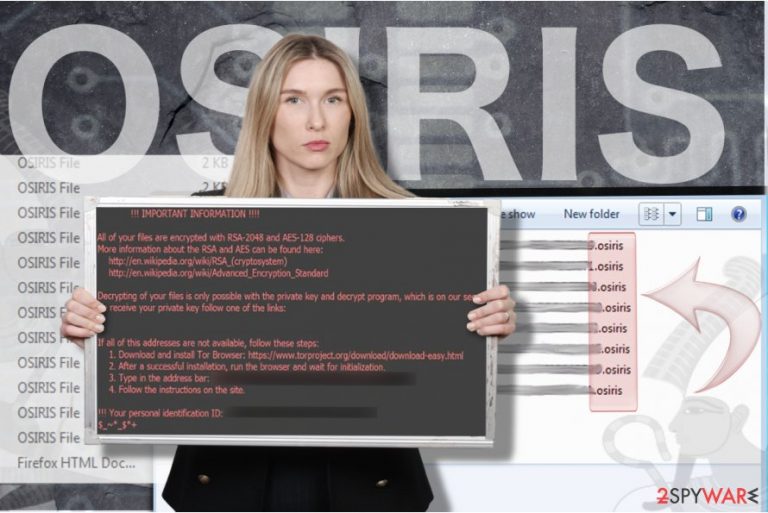
Finally, the ransomware changes the desktop picture with the traditional Locky wallpaper (black background with a red text). Ransomware, just like the previous versions of Locky, suggests buying Locky Decryptor[2], which sells for 0.5-4 Bitcoins. BTC is a virtual currency that almost all ransomware virus demands. Paying in Bitcoins helps criminals stay anonymous. The victim is asked to buy Bitcoins online and then transfer them to provided Bitcoin wallet.
All victims are advised to take care of the virus elimination as soon as it locks their files. The computer needs to be cleaned professionally because the latest versions of Locky are delivering additional malware to systems and also enrolling infected computers into botnets. Please do not try to remove Osiris ransomware manually, as you can do more harm than good to your PC.
Why should you NEVER pay the ransom
If your records have been compromised by the latest Locky ransomware variant, you might start thinking about whether to pay the ransom or not. We understand that personal files are extremely important and that no one wishes to lose them in half an hour or less.
However, organizations like hospitals or governments cannot allow themselves to lose all data because they just cannot function without it, so there are lots of cases when certain institutions paid an enormous ransom to decrypt encrypted data (for example, the Hollywood Presbyterian Medical Center paid $17,000[3]).
There were some cases when victims paid the ransom but never received an answer from perpetrators. Therefore, we suggest you make ransomware removal a top-priority task. If you are a home user, you can restore some of your files from data storage devices like USB or CD, or even better – from a hard disk that you’ve kept your backup in. Sadly, without a backup, data recovery is impossible.
We strongly recommend all victims read the FBI’s announcement[4] about ransomware viruses to learn how to protect their files from data-encrypting malware.
The distribution methods used by ransomware developers
Recent news shows that current Locky versions are currently distributed via obfuscated emails with the “Photo/Scan/Document from office” line in the Subject line. Such emails contain a malicious attachment (.zip file), which, once extracted, drops the .vbs file on the system.
If the victim lets the curiosity win and opens this file, one simply activates the destructive ransomware payload. The .vbs file rapidly connects to online servers and, without the user’s permission, downloads Locky to the system. The virus activates itself without displaying any setups or notifications and encrypts all records in minutes.
Besides, a new distribution technique was spotted recently. It appears that currently, Locky spreads via Facebook messages in the form of a photo_9166.svg file[5]. Similar to the previous versions, the Osiris ransomware also asks you to enable macro settings.
Besides, a new distribution technique was spotted recently. It appears that currently, Locky spreads via Facebook messages in the form of a photo_9166.svg file. Similar to previous versions, the file virus also asks you to enable macro settings. Later on, the payload is delivered via the Rundll32.exe file. Then, a DLL installer will be downloaded and placed in the %Temp% folder. You might notice these files as they bear .spe extension. In addition, beware of the spam email named “New(910).”
From: Savannah [Savannah807@victimdomain.tld]
Reply-To: Savannah [Savannah807@victimdomain.tld]
Date: 12 December 2016 at 09:50
Subject: New(910)Scanned by CamScanner
Sent from Yahoo Mail on Android
Beware of the scams which claim “unsuccessfully delivered emails.” There has been a tendency to inject malware in such messages[6]. However, Osiris is also delivered in more sophisticated ways, for example, with the help of exploit kits and Trojans.
Reportedly, this ransomware can be delivered with the help of Pony Trojan, Nemucod, and other malicious software. To learn more about Locky's dissemination peculiarities, navigate to this page: Locky virus: modus operandi, distribution, and removal methods.
Remove Osiris ransomware virus immediately
The virus must be eliminated properly because it is a very dangerous crypto-malware that belongs to the Locky family. It can damage your files or remove them from your computer without leaving you a chance to recover them. Once it infiltrates the system, ransomware compromises it and can use additional tools to carry out illegal activities. Therefore, to delete it and avoid problems related to this procedure, we suggest using reliable security software.
To start Osiris removal, you may need to restart your PC as instructed below because sometimes this virus tends to block its victims. Lastly, keep in mind that your personal cautiousness is significant while trying to prevent ransomware viruses[7], even if security specialists initiate constant automatic updates of your software and the operating system in general to lower the risk of ransomware.
Getting rid of Osiris virus. Follow these steps
Isolate the infected computer
Some ransomware strains aim to infect not only one computer but hijack the entire network. As soon as one of the machines is infected, malware can spread via network and encrypt files everywhere else, including Network Attached Storage (NAS) devices. If your computer is connected to a network, it is important to isolate it to prevent re-infection after ransomware removal is complete.
The easiest way to disconnect a PC from everything is simply to plug out the ethernet cable. However, in the corporate environment, this might be extremely difficult to do (also would take a long time). The method below will disconnect from all the networks, including local and the internet, isolating each of the machines involved.
- Type in Control Panel in Windows search and press Enter
- Go to Network and Internet
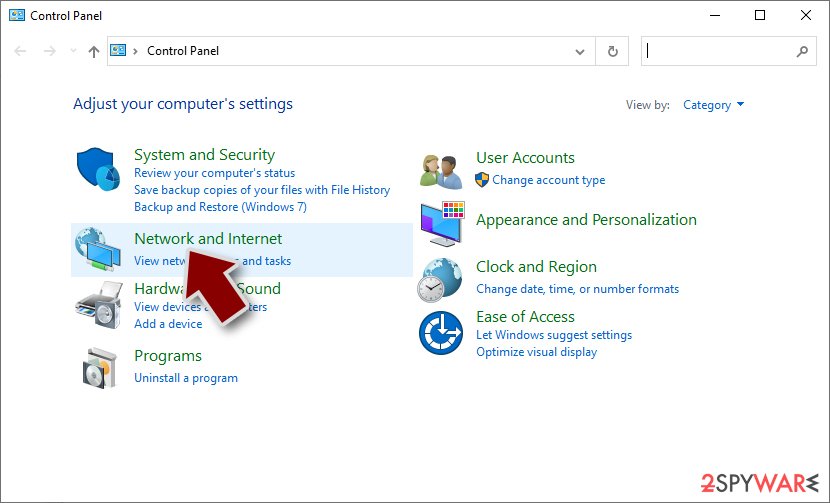
- Click Network and Sharing Center
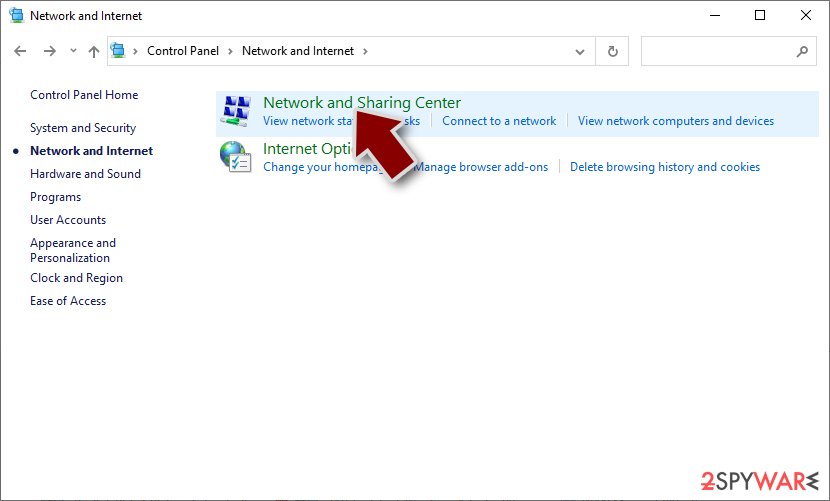
- On the left, pick Change adapter settings
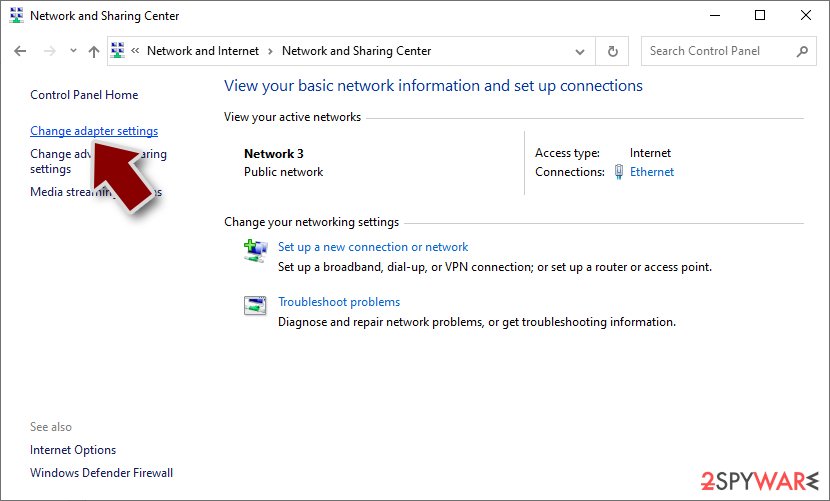
- Right-click on your connection (for example, Ethernet), and select Disable
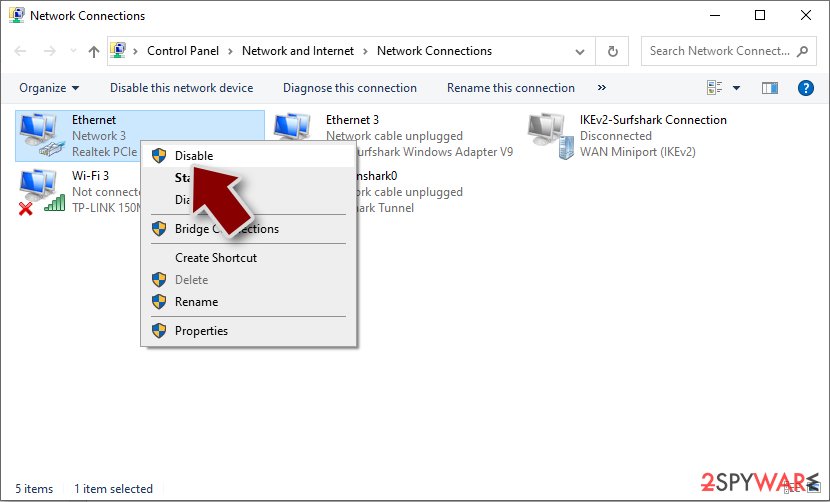
- Confirm with Yes.
If you are using some type of cloud storage you are connected to, you should disconnect from it immediately. It is also advisable to disconnect all the external devices, such as USB flash sticks, external HDDs, etc. Once the malware elimination process is finished, you can connect your computers to the network and internet, as explained above, but by pressing Enable instead.
Scan your system with anti-malware
If you are a victim of ransomware, you should employ anti-malware software for its removal. Some ransomware can self-destruct after the file encryption process is finished. Even in such cases, malware might leave various data-stealing modules or could operate in conjunction with other malicious programs on your device.
SpyHunter 5Combo Cleaner or Malwarebytes can detect and eliminate all ransomware-related files, additional modules, along with other viruses that could be hiding on your system. The security software is really easy to use and does not require any prior IT knowledge to succeed in the malware removal process.
Repair damaged system components
Once a computer is infected with malware, its system is changed to operate differently. For example, an infection can alter the Windows registry database, damage vital bootup and other sections, delete or corrupt DLL files, etc. Once a system file is damaged by malware, antivirus software is not capable of doing anything about it, leaving it just the way it is. Consequently, users might experience performance, stability, and usability issues, to the point where a full Windows reinstall is required.
Therefore, we highly recommend using a one-of-a-kind, patented technology of FortectIntego repair. Not only can it fix virus damage after the infection, but it is also capable of removing malware that has already broken into the system thanks to several engines used by the program. Besides, the application is also capable of fixing various Windows-related issues that are not caused by malware infections, for example, Blue Screen errors, freezes, registry errors, damaged DLLs, etc.
- Download the application by clicking on the link above
- Click on the ReimageRepair.exe

- If User Account Control (UAC) shows up, select Yes
- Press Install and wait till the program finishes the installation process
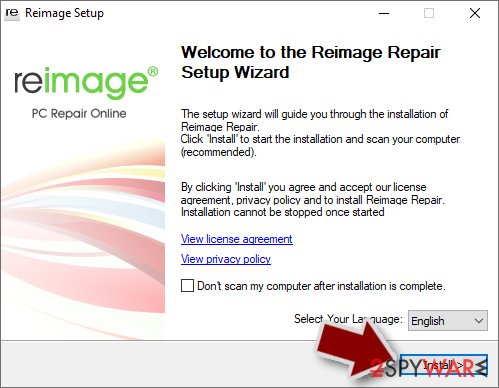
- The analysis of your machine will begin immediately
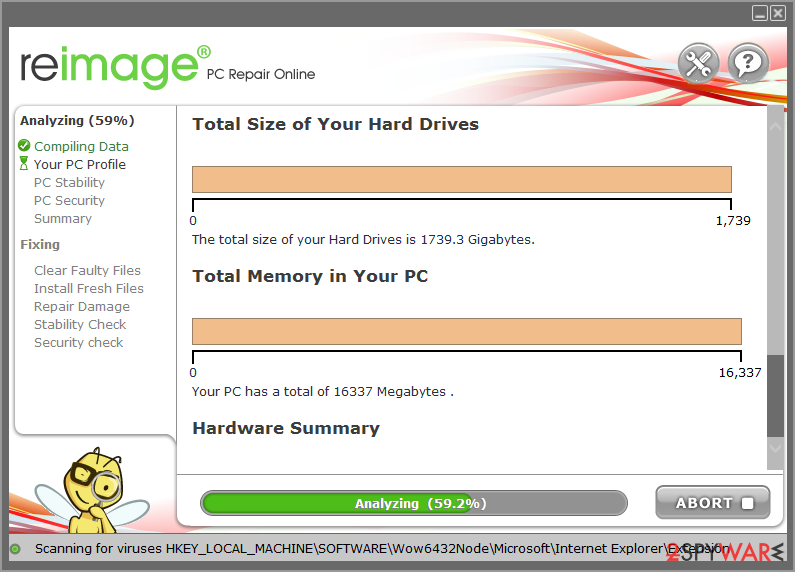
- Once complete, check the results – they will be listed in the Summary
- You can now click on each of the issues and fix them manually
- If you see many problems that you find difficult to fix, we recommend you purchase the license and fix them automatically.
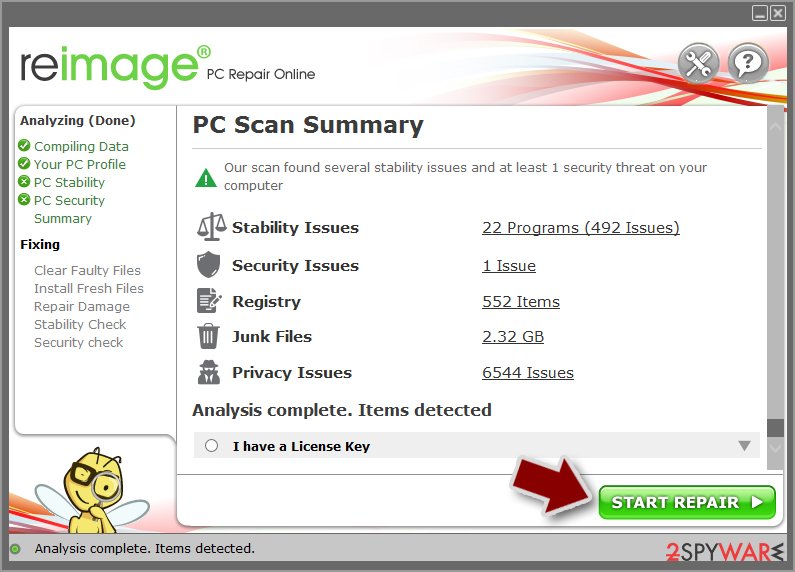
By employing FortectIntego, you would not have to worry about future computer issues, as most of them could be fixed quickly by performing a full system scan at any time. Most importantly, you could avoid the tedious process of Windows reinstallation in case things go very wrong due to one reason or another.
Restore files using data recovery software
Since many users do not prepare proper data backups prior to being attacked by ransomware, they might often lose access to their files permanently. Paying criminals is also very risky, as they might not fulfill the promises and never send back the required decryption tool.
While this might sound terrible, not all is lost – data recovery software might be able to help you in some situations (it highly depends on the encryption algorithm used, whether ransomware managed to complete the programmed tasks, etc.). Since there are thousands of different ransomware strains, it is immediately impossible to tell whether third-party software will work for you.
Therefore, we suggest trying regardless of which ransomware attacked your computer. Before you begin, several pointers are important while dealing with this situation:
- Since the encrypted data on your computer might permanently be damaged by security or data recovery software, you should first make backups of it – use a USB flash drive or another storage.
- Only attempt to recover your files using this method after you perform a scan with anti-malware software.
Install data recovery software
- Download Data Recovery Pro.
- Double-click the installer to launch it.

- Follow on-screen instructions to install the software.
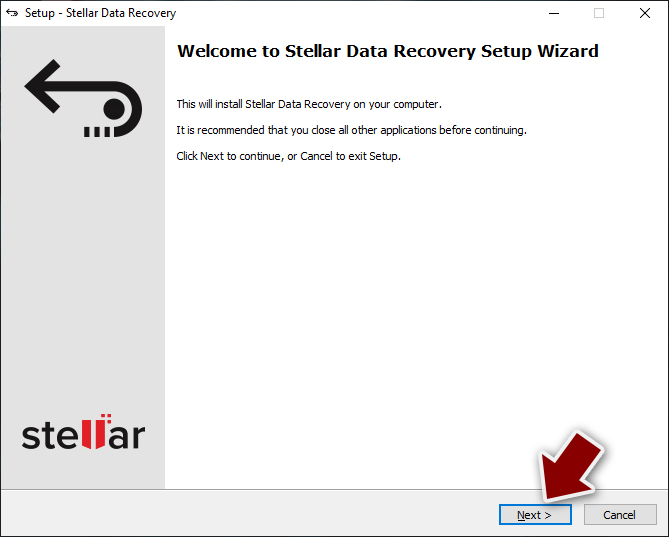
- As soon as you press Finish, you can use the app.
- Select Everything or pick individual folders where you want the files to be recovered from.
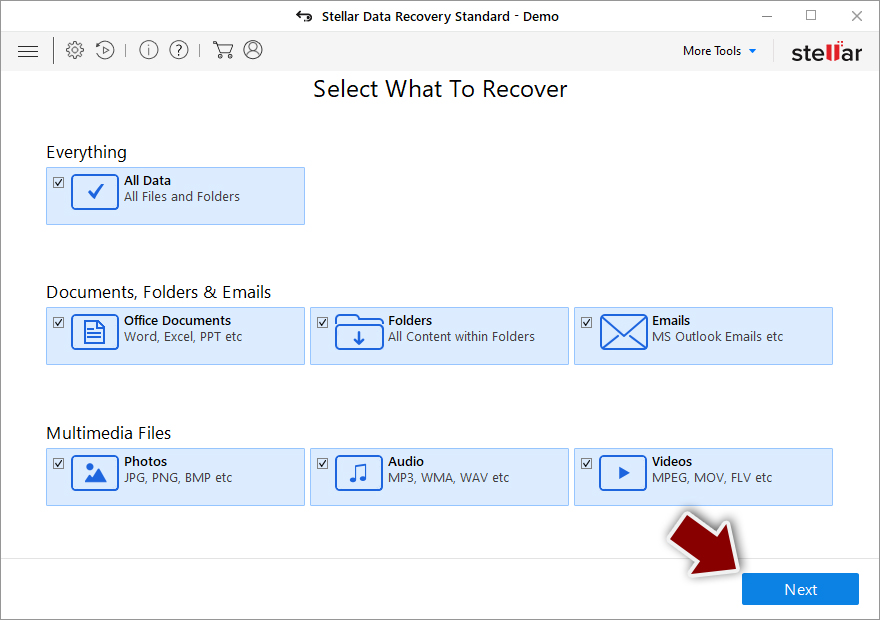
- Press Next.
- At the bottom, enable Deep scan and pick which Disks you want to be scanned.
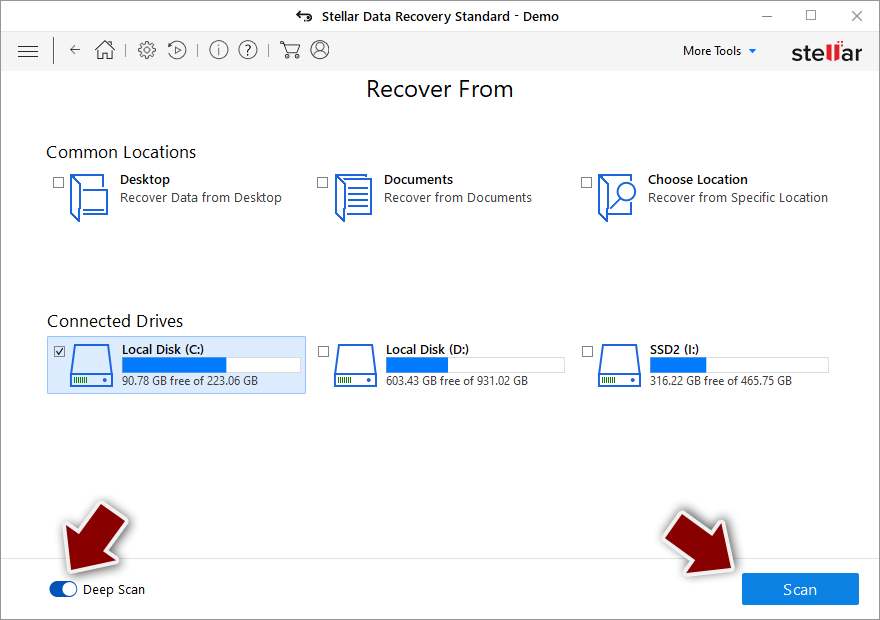
- Press Scan and wait till it is complete.
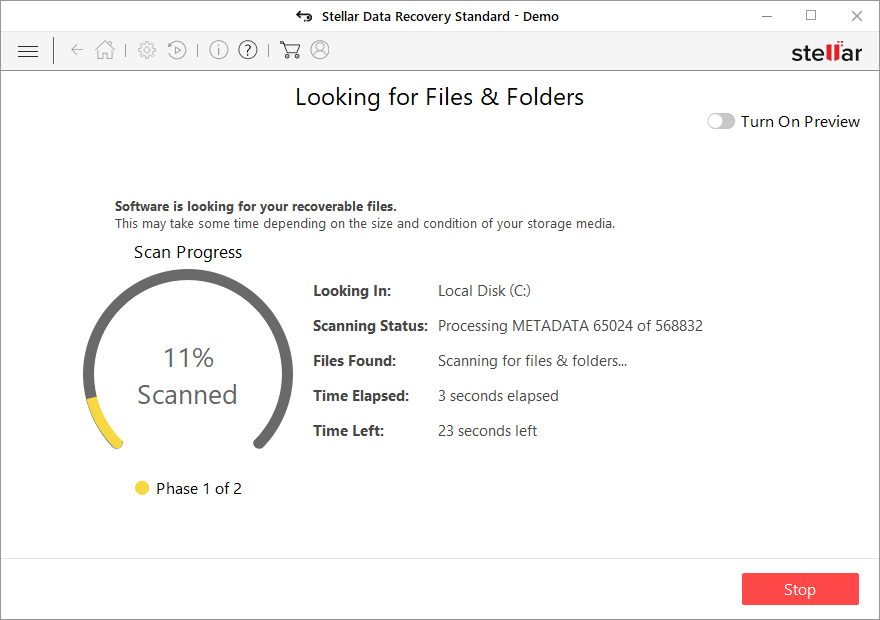
- You can now pick which folders/files to recover – don't forget you also have the option to search by the file name!
- Press Recover to retrieve your files.
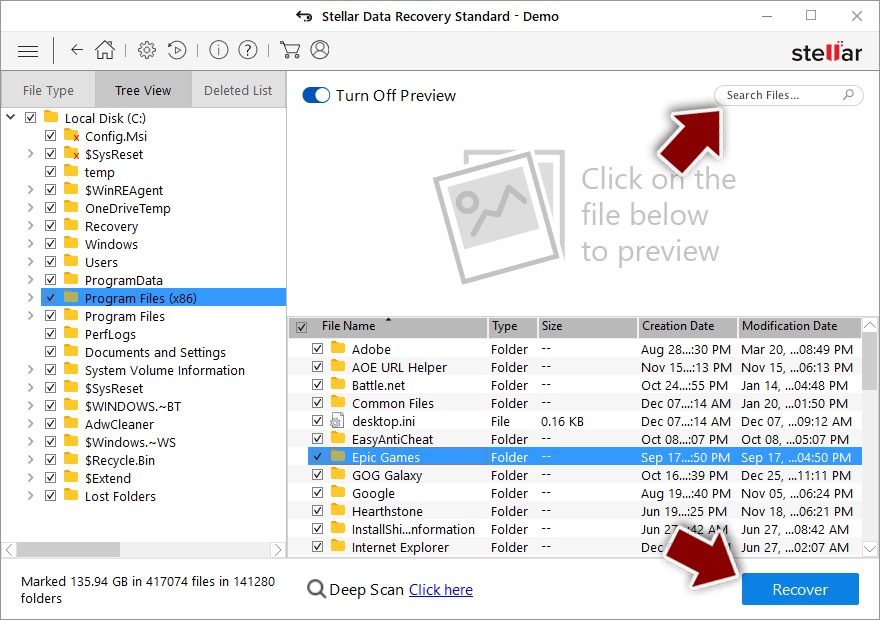
Create data backups to avoid file loss in the future
One of the many countermeasures for home users against ransomware is data backups. Even if your Windows get corrupted, you can reinstall everything from scratch and retrieve files from backups with minimal losses overall. Most importantly, you would not have to pay cybercriminals and risk your money as well.
Therefore, if you have already dealt with a ransomware attack, we strongly advise you to prepare backups for future use. There are two options available to you:
- Backup on a physical external drive, such as a USB flash drive or external HDD.
- Use cloud storage services.
The first method is not that convenient, however, as backups need to constantly be updated manually – although it is very reliable. Therefore, we highly advise choosing cloud storage instead – it is easy to set up and efficient to sustain. The problem with it is that storage space is limited unless you want to pay for the subscription.
Using Microsoft OneDrive
OneDrive is a built-in tool that comes with every modern Windows version. By default, you get 5 GB of storage that you can use for free. You can increase that storage space, but for a price. Here's how to setup backups for OneDrive:
- Click on the OneDrive icon within your system tray.
- Select Help & Settings > Settings.
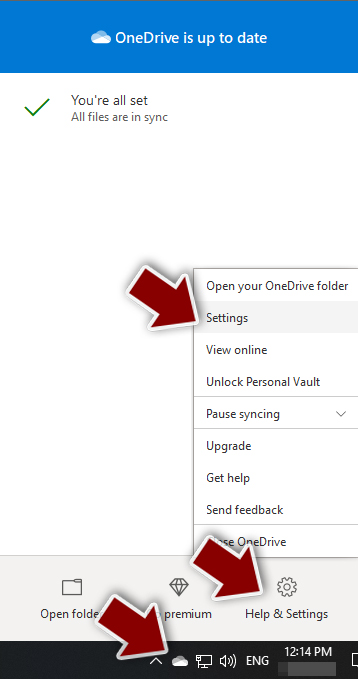
- If you don't see your email under the Account tab, you should click Add an account and proceed with the on-screen instructions to set yourself up.
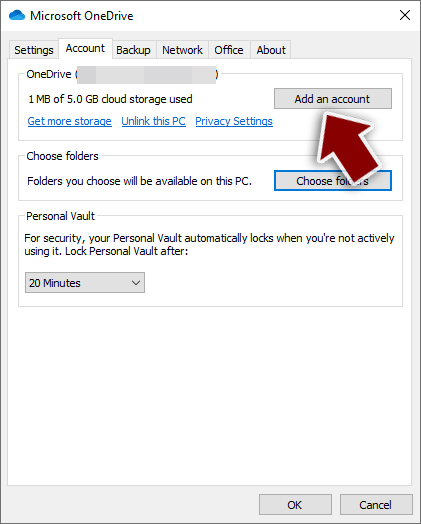
- Once done, move to the Backup tab and click Manage backup.
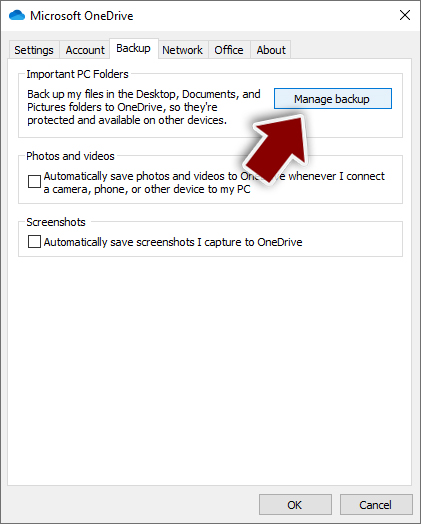
- Select Desktop, Documents, and Pictures, or a combination of whichever folders you want to backup.
- Press Start backup.
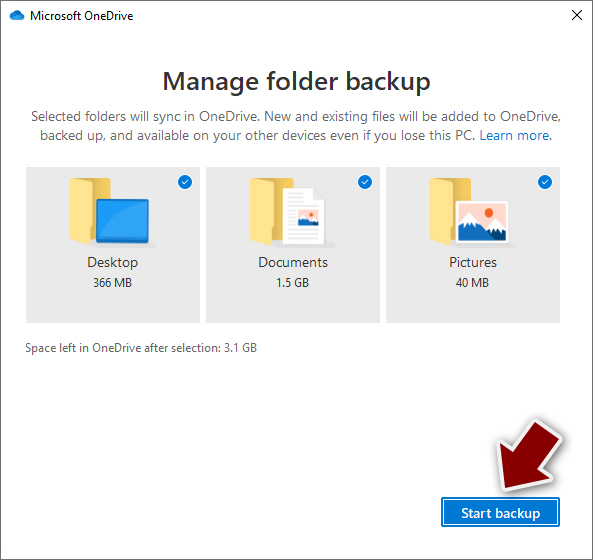
After this, all the files that are imported into the above-mentioned folders will be automatically backed for you. If you want to add other folders or files, you have to do that manually. For that, open File Explorer by pressing Win + E on your keyboard, and then click on the OneDrive icon. You should drag and drop folders you want to backup (or you can use Copy/Paste as well).
Using Google Drive
Google Drive is another great solution for free backups. The good news is that you get as much as 15GB for free by choosing this storage. There are also paid versions available, with significantly more storage to choose from.
You can access Google Drive via the web browser or use a desktop app you can download on the official website. If you want your files to be synced automatically, you will have to download the app, however.
- Download the Google Drive app installer and click on it.

- Wait a few seconds for it to be installed.
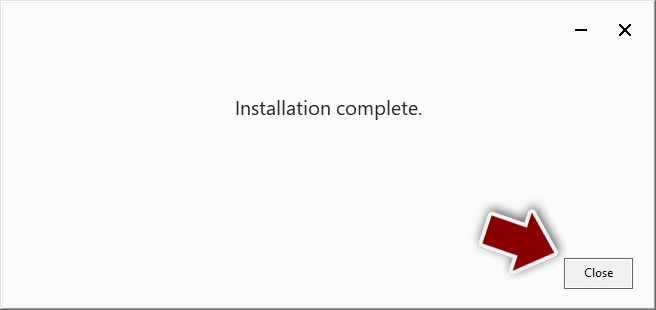
- Now click the arrow within your system tray – you should see Google Drive icon there, click it once.
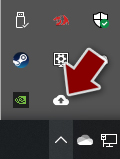
- Click Get Started.
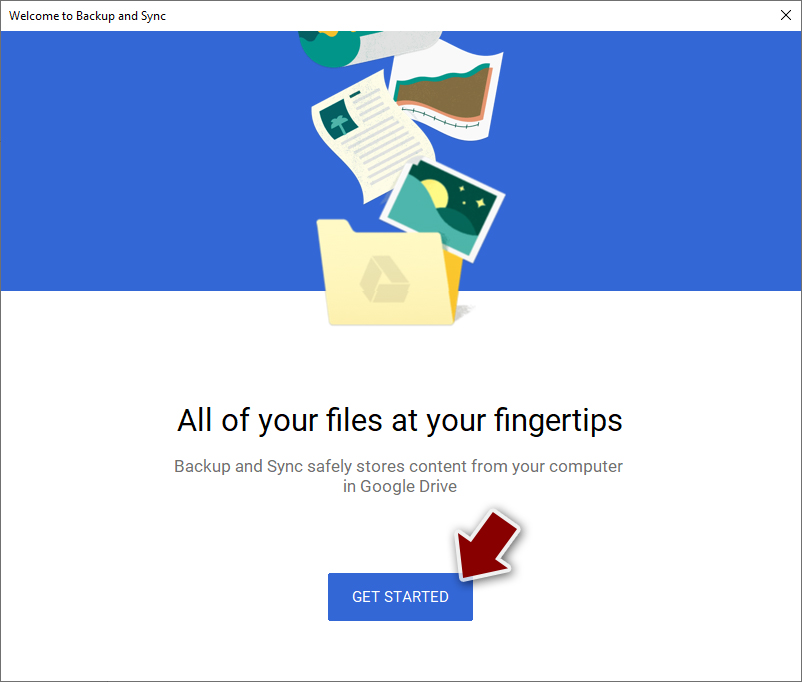
- Enter all the required information – your email/phone, and password.
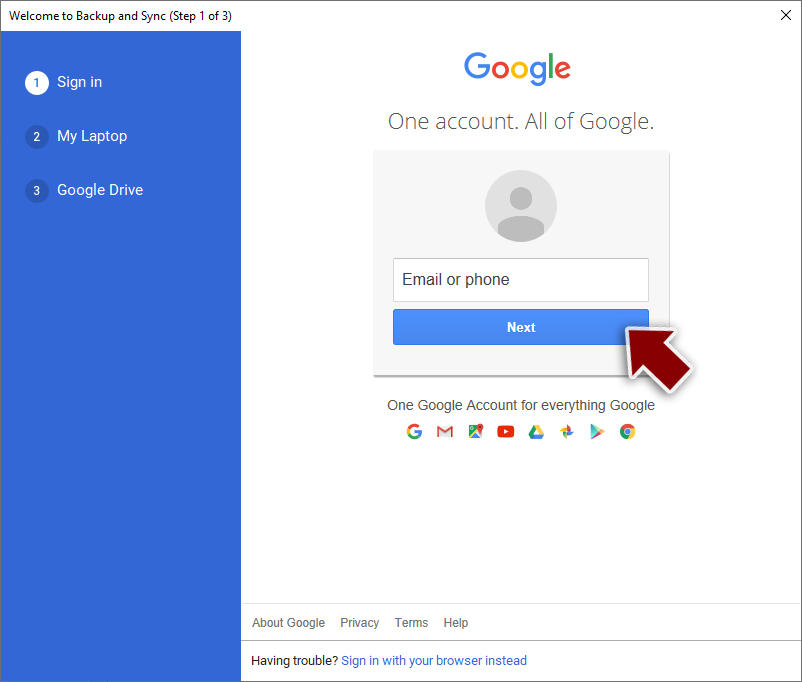
- Now pick what you want to sync and backup. You can click on Choose Folder to add additional folders to the list.
- Once done, pick Next.
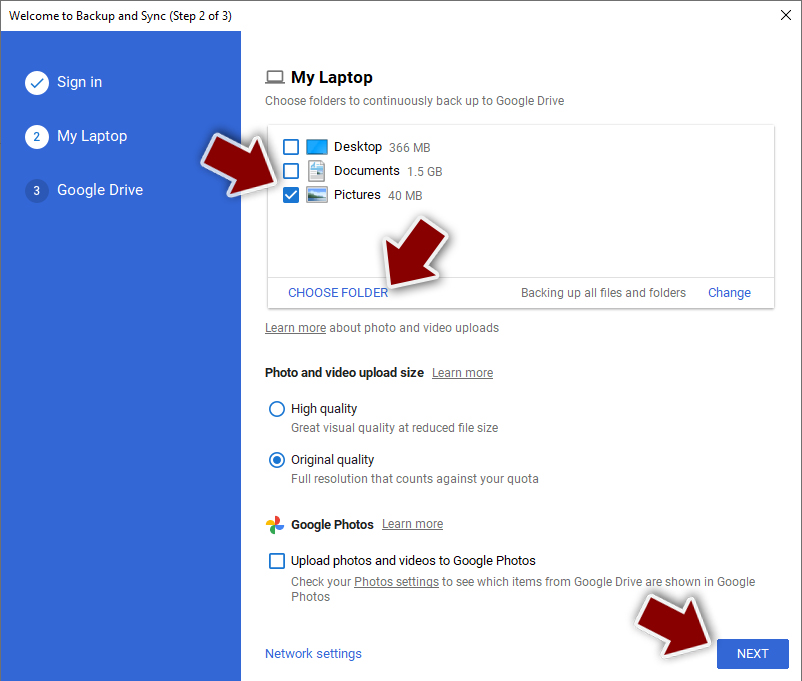
- Now you can select to sync items to be visible on your computer.
- Finally, press Start and wait till the sync is complete. Your files are now being backed up.
Manual removal using Safe Mode
Important! →
Manual removal guide might be too complicated for regular computer users. It requires advanced IT knowledge to be performed correctly (if vital system files are removed or damaged, it might result in full Windows compromise), and it also might take hours to complete. Therefore, we highly advise using the automatic method provided above instead.
Step 1. Access Safe Mode with Networking
Manual malware removal should be best performed in the Safe Mode environment.
Windows 7 / Vista / XP
- Click Start > Shutdown > Restart > OK.
- When your computer becomes active, start pressing F8 button (if that does not work, try F2, F12, Del, etc. – it all depends on your motherboard model) multiple times until you see the Advanced Boot Options window.
- Select Safe Mode with Networking from the list.

Windows 10 / Windows 8
- Right-click on Start button and select Settings.

- Scroll down to pick Update & Security.

- On the left side of the window, pick Recovery.
- Now scroll down to find Advanced Startup section.
- Click Restart now.

- Select Troubleshoot.

- Go to Advanced options.

- Select Startup Settings.

- Press Restart.
- Now press 5 or click 5) Enable Safe Mode with Networking.

Step 2. Shut down suspicious processes
Windows Task Manager is a useful tool that shows all the processes running in the background. If malware is running a process, you need to shut it down:
- Press Ctrl + Shift + Esc on your keyboard to open Windows Task Manager.
- Click on More details.

- Scroll down to Background processes section, and look for anything suspicious.
- Right-click and select Open file location.

- Go back to the process, right-click and pick End Task.

- Delete the contents of the malicious folder.
Step 3. Check program Startup
- Press Ctrl + Shift + Esc on your keyboard to open Windows Task Manager.
- Go to Startup tab.
- Right-click on the suspicious program and pick Disable.

Step 4. Delete virus files
Malware-related files can be found in various places within your computer. Here are instructions that could help you find them:
- Type in Disk Cleanup in Windows search and press Enter.

- Select the drive you want to clean (C: is your main drive by default and is likely to be the one that has malicious files in).
- Scroll through the Files to delete list and select the following:
Temporary Internet Files
Downloads
Recycle Bin
Temporary files - Pick Clean up system files.

- You can also look for other malicious files hidden in the following folders (type these entries in Windows Search and press Enter):
%AppData%
%LocalAppData%
%ProgramData%
%WinDir%
After you are finished, reboot the PC in normal mode.
Finally, you should always think about the protection of crypto-ransomwares. In order to protect your computer from Osiris and other ransomwares, use a reputable anti-spyware, such as FortectIntego, SpyHunter 5Combo Cleaner or Malwarebytes
How to prevent from getting ransomware
Stream videos without limitations, no matter where you are
There are multiple parties that could find out almost anything about you by checking your online activity. While this is highly unlikely, advertisers and tech companies are constantly tracking you online. The first step to privacy should be a secure browser that focuses on tracker reduction to a minimum.
Even if you employ a secure browser, you will not be able to access websites that are restricted due to local government laws or other reasons. In other words, you may not be able to stream Disney+ or US-based Netflix in some countries. To bypass these restrictions, you can employ a powerful Private Internet Access VPN, which provides dedicated servers for torrenting and streaming, not slowing you down in the process.
Data backups are important – recover your lost files
Ransomware is one of the biggest threats to personal data. Once it is executed on a machine, it launches a sophisticated encryption algorithm that locks all your files, although it does not destroy them. The most common misconception is that anti-malware software can return files to their previous states. This is not true, however, and data remains locked after the malicious payload is deleted.
While regular data backups are the only secure method to recover your files after a ransomware attack, tools such as Data Recovery Pro can also be effective and restore at least some of your lost data.
- ^ Æsir. Wikipedia, the free encyclopedia.
- ^ Ugnius Kiguolis. Locky decrypter. How to delete? (Removal tutorial). NoVirus. Comprehensive information about various computer infections.
- ^ Thomas Fox-Brewster. As Ransomware Crisis Explodes, Hollywood Hospital Coughs Up $17,000 In Bitcoin. Forbes. Business news and financial news.
- ^ Incidents of Ransomware on the Rise. FBI News. Featured News.
- ^ Swati Khandelwal. Spammers using Facebook Messenger to Spread Locky Ransomware. The Hacker News. Security in a serious way.
- ^ Suzanne Monyak. Here’s Your Friendly Holiday Reminder Not to Click on “Undelivered Package” Emails. Future Tense. The Citizen's Guide to the Future.
- ^ A Guide To Avoid Being A Crypto Ransomware Victim. Business Solutions.The Growth Strategies For the IT Channel.
